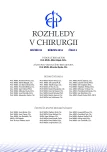Atypical, extra pancreatic pseudocyst of the pancreas
Authors:
L. Havlůj; B. Mlýnek; R. Gürlich
Authors place of work:
Chirurgická klinika 3. LF Univerzity Karlovy a FN Královské Vinohrady
přednosta: prof. MUDr. R. Gürlich, CSc.
Published in the journal:
Rozhl. Chir., 2016, roč. 95, č. 3, s. 126-130.
Category:
Case Report
Summary
The pseudocyst of the pancreas is one of the most common cystic lesions of the pancreas. The pseudocysts can be defined as intrapancreatic, peripancreatic or extrapancreatic fluid collections with a defined wall formed mostly on the basis of acute or chronic pancreatitis. This is a relatively common complication of acute or chronic pancreatitis. Sonography is essential for the diagnosis given its noninvasivity and availability. Other assessments that show the highest accuracy, specificity and sensitivity include MDCT and ERCP. The MDCT and ERCP assessments can be used to classify the pseudocyst; the treatment algorithm is then determined based on this classification. MDCT should ideally be preceded by ERCP. EUS-FNAB or aspiration with the determination of oncomarkers and AMS in the aspirate have been shown to be most important to distinguish the pseudocyst from malignant cystic lesions. Functional classification of the pseudocyst is an important prerequisite for successful algorithm of the treatment. The classification is based mainly upon anatomical relations of the pseudocyst to the pancreatic outlet and morphology of the pancreatic parenchyma. Percutaneous drainage, endoscopic and surgical methods are mainly applied in the treatment. The authors present a case report of a very rare extrapancreatic pseudocyst.
Key words:
pseudocyst − pancreatic pseudocyst classification − extrapancreatic pseudocyst
Zdroje
1. Andrén-Sandberg A, Dervenis Ch. Pancreatic pseudocysts in the 21st century. Part I: Classification, pathophysiology, anatomic considerations and treatment. JOP (Online) 2004;5:8−24.
2. Moon SB, Lee HW, Park KW, et al. Falciform ligament abscess after omphalitis: Report of a case. J Korean Med Sci 2010;25:1090−2.
3. Tsukuda K, Furutani K, Nakahara S, et al. Abscess formation of the round ligament of the liver: report of a case. Acta Medica Okayama 2008;62:411−3.
4. van Vugt ST, Gerritsen DJ. Liver abscess following navel piercing. Ned Tijdschr Geneeskd 2005;149:1588−9.
5. Ko SF, Chen YS, Ng SH, et al. Mucin-hypersecreting papillary cholangiocarcinoma presenting as abdominal wall abscess: CT and spiral CT cholangiography. Abdom Imaging 1996;21:222−5.
6. Bradley EL 3rd. A clinically based classification system for acute pancreatitis. Arch Surg 1993;128:586−90.
7. Bradley E, Clements JL Jr, Gonzales AC. The natural history of pancreatic pseudocysts: a unified concept of management. Am J Surg 1979;137:135−41.
8. Traverso LW, Kozarek RA. Pancreatoduodenectomy for chronic pancreatitis: anatomic selection criteria and subsequent long-term outcome analysis. Ann Surg 1997;226:429−35.
9. D’Egidio A, Schein M. Pancreatic pseudocysts: A proposed classification and its management implications. Br J Surg 1999;78: 981−4.
10. Heider R, Meyer AA, Galanko JA, et al. Percutaneous drainage of pancreatic pseudocysts is associated with a higher failure rate than surgical treatment in unselected patients. Ann Surg 1999;6:781−89.
11. Van Sonnenberg E, Wittich GR, Casola G, et al. Percutaneous drainage of infected and noninfected pancreatic pseudocysts: experience in 101 cases. Radiology 1989;170:757−61.
12. Criadoe Desterano AA, Weiner TM, Jacques PF. Long-term results of percutaneous catheter drainage of pancreatic pseudocysts. Surg Gynecol Obstet 1992;175:293−7.
13. Adams DB, Anderson MC. Percutaneous catheter drainage compared with internal drainage in the management of pancreatic pseudocyst. Ann Surg 1992;215:571–8.
14. Nealon WH, Wasler E. Main pancreatic ductal anatomy can direct choice of modality for treating pancreatic pseudocysts (surgery versus percutaneous drainage). Ann Surg 2002;235:751−8.
15. Chak A. Endosonographic-guided therapy of pancreatic pseudocysts. Gastrointest Endosc 2000; 52(6 Suppl):S23−7.
16. Gürlich R, Sixta B, Oliverius M, et al. Laparoscopic distal resection of the pancreas. Rozhl Chir 2005;84:463−5.
17. Nakao A. Pancreatic head resection with segmental duodenectomy and preservation of the gastroduodenal artery. Hepato-gastroenterology 1998;45:533−5.
18. Balzan S, Kianmanesh R, Farges O, et al. Right intrahepatic pseudocyst following acute pancreatitis: an unusual location after acute pancreatitis. J Hepatobiliary Pancreat Surg 2005;12:135–7.
19. Mahmood NS, Suresh HB. Intrahepatic pancreatic pseudocyst complicating chronic calcific pancreatitis − a rare cause for a cystic liver lesion. The Internet Journal of Radiology 2010;11:2.
20. Pitchumoni CS, Agarwal N. Pancreatic pseudocysts. When and how should drainage be performed? Gastroenterol Clin North Am 1999;28:615−39.
Štítky
Surgery Orthopaedics Trauma surgeryČlánok vyšiel v časopise
Perspectives in Surgery

2016 Číslo 3
- Metamizole at a Glance and in Practice – Effective Non-Opioid Analgesic for All Ages
- Metamizole vs. Tramadol in Postoperative Analgesia
- Spasmolytic Effect of Metamizole
Najčítanejšie v tomto čísle
- Atypical, extra pancreatic pseudocyst of the pancreas
- Optimal timing of laparoscopic cholecystectomy in treatment of acute cholecystitis
- Lumbar sympathectomy − literature review over the past 15 years
- Giant aneurysm of the abdominal aorta and iliac arteries
